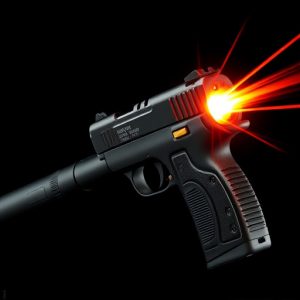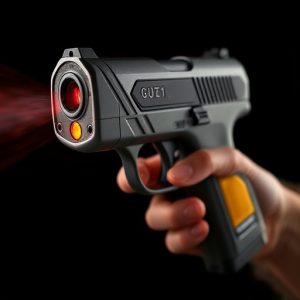Hot Shot Stun Gun: Optimizing Electrode Spacing for Maximum Impact
Hot Shot Stun Guns excel due to their precise electrode spacing, strategically designed for optimal…….
Hot Shot Stun Guns excel due to their precise electrode spacing, strategically designed for optimal current distribution and effective muscle disruption. This innovative configuration enables swift and reliable incapacitation, with balanced electric fields covering large areas without excessive concentration. The ideal spacing varies based on target size, ensuring both smaller individuals and larger attackers receive potent shocks while minimizing discomfort or over-stimulation. For self-defense, this strategic electrode design is key to the Hot Shot Stun Gun's market leadership, offering users peace of mind with quick, effective protection against threats.
Uncover the secrets behind stun gun effectiveness with a focus on electrode spacing. This comprehensive guide explores how stun guns work and the crucial role of electrode placement, particularly highlighting the innovative design of the Hot Shot Stun Gun. Delve into the science behind optimal electrode configuration to maximize impact. From real-world applications to enhancing performance, understand why electrode spacing is key in determining a stun gun’s success. Discover the factors that make the Hot Shot Stun Gun a top choice for those seeking maximum protection and effectiveness.
- Understanding Stun Gun Functionality and Electrode Placement
- Hot Shot Stun Gun: Unveiling Its Unique Features and Design
- The Science Behind Effective Electrodes Spacing for Maximum Impact
- Optimal Electrode Configuration: Enhancing Stun Gun Performance
- Real-World Applications: How Electrode Spacing Affects Stun Gun Effectiveness
Understanding Stun Gun Functionality and Electrode Placement
Stun guns, also known as electroshock weapons or TASERs (Tactical Electrical Weapons and Systems), operate by delivering an electric current through two electrodes to disrupt muscular control in the target. This causes a powerful muscle spasms, temporarily incapacitating the individual. The effectiveness of a stun gun heavily relies on the electrode spacing and placement.
Hot Shot Stun Guns, for instance, employ precision-engineered electrodes designed to maximize impact while minimizing energy use. The optimal distance between these electrodes is crucial; too close and it may cause excessive discomfort or even electrical shocks, while too far can result in reduced effectiveness. Proper placement ensures the electric current flows through the target’s body efficiently, leading to a faster and more reliable incapacitation. Understanding this dynamic relationship between electrode spacing and stun gun functionality is key to ensuring both safety and optimal performance when using such devices.
Hot Shot Stun Gun: Unveiling Its Unique Features and Design
The Hot Shot Stun Gun stands out in the market for its innovative design and effective features, making it a preferred choice among personal safety advocates. This stun gun is meticulously crafted with a focus on both functionality and style, ensuring users have a powerful self-defense tool that also exudes confidence. Its unique electrode spacing is a game-changer, delivering precise and potent shocks to disable attackers quickly and efficiently.
With a compact yet robust build, the Hot Shot Stun Gun is easy to carry and use, providing peace of mind in various situations. The strategic arrangement of electrodes allows for optimal current distribution, maximizing the stun effect while minimizing energy waste. This advanced technology promises users an extra layer of protection, ensuring they can deter potential threats with confidence.
The Science Behind Effective Electrodes Spacing for Maximum Impact
The design and spacing of electrodes in a stun gun, such as the Hot Shot Stun Gun, play a pivotal role in determining its effectiveness. Electrodes are the critical components that deliver an electric current to disrupt muscular control in a target, causing temporary incapacitation. The scientific principle behind optimal electrode spacing lies in creating a balanced field of electricity, ensuring maximum charge distribution across the contact area.
When electrodes are strategically spaced, they allow for precise targeting and efficient current flow. This ensures that the stun gun’s electric discharge covers a substantial surface area without excessive concentration in any one spot. Such balanced spacing enhances the device’s impact, enabling it to overcome muscular contractions and cause muscle fatigue more swiftly, thereby increasing the likelihood of successful incapacitation.
Optimal Electrode Configuration: Enhancing Stun Gun Performance
The optimal electrode configuration plays a pivotal role in enhancing the performance of a hot shot stun gun. Stun guns rely on electrical current to disrupt muscular control, rendering the target immobilized. By strategically placing electrodes, the device can maximize its impact and ensure a more effective stun. Typically, stun guns feature two main electrodes: one positive and one negative. The distance between these electrodes, or electrode spacing, significantly influences the intensity of the electric field generated.
For optimal performance, experts recommend maintaining a precise electrode spacing. A well-designed configuration allows for uniform current distribution across the target area, leading to quicker and more powerful shocks. Narrower electrode spacing can increase the concentration of electrical energy, making the stun gun more effective on larger targets. Conversely, wider spacing is beneficial for smaller or heavily muscled individuals, ensuring a thorough shock delivery without unnecessary over-stimulation.
Real-World Applications: How Electrode Spacing Affects Stun Gun Effectiveness
In real-world applications, the effectiveness of a hot shot stun gun directly correlates with electrode spacing. Stun guns use electric current to disrupt muscle control and cause temporary paralysis in the target. Electrodes, which deliver the electrical charge, must be strategically placed to maximize their impact. Closely spaced electrodes allow for more precise targeting, ensuring that the current flows directly through the center of the body, disrupting vital neural pathways. This results in a quicker response time and increased stun effectiveness.
In contrast, wider electrode spacing can lead to less focused delivery of the electric shock. While this may still cause discomfort or incapacitation, it might not be as swift or reliable as the targeted approach. Therefore, for optimal performance, stun guns should be designed with careful consideration of electrode placement and spacing, ensuring they meet the demands of various self-defense scenarios where speed and reliability are paramount.
The optimal electrode spacing in a hot shot stun gun is a critical factor that significantly influences its effectiveness. Understanding the science behind this design element allows users to maximize the impact of their stun device, ensuring superior performance in real-world scenarios. By carefully configuring the electrodes, users can enhance the stun gun’s ability to disrupt muscle control, providing a more reliable and powerful defense mechanism. This knowledge is essential for those seeking personal safety and peace of mind, especially in high-risk environments.


